Information on streetscapes
Here you will find useful information on the various features of streetscapes.
Tactile Paving
Guidance on tactile paving states that there are six different types.
Visibility Scotland will provide their interpretation of tactile paving. The Department of Transport guidance on Tactile paving should always be the primary reference source. Department of Transport guidance
Tactile paving surfaces are important because they convey vital environmental information to people with low or no vision. These include hazard warnings and directional guidance, thereby supporting independent mobility. Tactile paving surfaces can be read by foot or cane.
Blister paving
The profile of the blister surface is a series of tactile (raised dots all in a uniform sequence). Blister paving is used to mark road crossings.
The guidance states that red blister paving with a stem/tail (much like an L shape) extending from the drop-down kerb to the shoreline (wall line) is used to mark a push-button-controlled crossing.
However, the colour of tactile paving can be changed to suit the environment’s heritage.
The control box should always be positioned on the right. However, this guidance is not always followed.
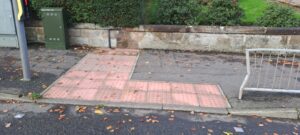
Picture of controlled crossing with red blister paving
Tan/sand-coloured blister paving is used for uncontrolled crossings.
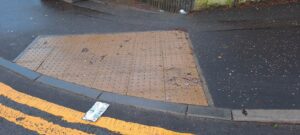
Picture of uncontrolled crossing with tan/ sand blister paving.
The guidance does not state that the stem/tail should extend to the shoreline. In this situation, it can make detecting the crossing particularly challenging for the blind or partially sighted traveller.
Offset blister paving
The profile of the offset blister surface is a series of tactile (raised dots) that are not in a uniform sequence. This is used to mark hazards.
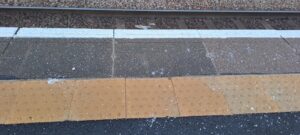
Picture of offset blister paving at a train platform.
The platform edge warning paving surface profile consists of offset rows of flat-topped domes (blister paving for road crossings is uniform – as in a row).
As the blister pattern is offset, it can be used to identify the direction in which the platform edge is running and the correct direction of travel to access a train.
Corduroy Hazard Warning Surface
The profile of the corduroy surface comprises rounded bars running transversely (across) the direction in which people will be walking.
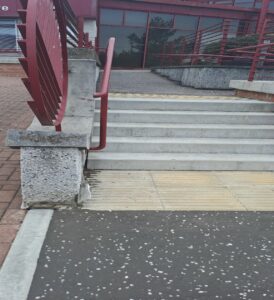
Picture of hazard warning – corduroy paving.
The corduroy surface conveys the message ’hazard, proceed with caution’. Its purpose is to warn people of the presence of specific hazards. This includes the top and bottom of the steps or a ramp.
Lozenge tactile paving
The profile of the warning surface comprises rows of uniformed ‘lozenge’ shapes. The lozenge shape is a round ‘pill-like’ shape that shares similarities to the archway shape.
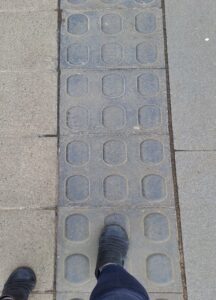
Picture of lozenge shape tactile paving.
The platform edge (on-street) warning surface warns people that they are approaching the edge of an on-street tram or other Light Rapid Transit (LRT) platform.
Guidance Path Surface
The profile of guidance tactile paving is intended to act as a guide across large paved spaces, with the bars lying parallel to the direction of travel. Where a turn is encountered, the alignment of the paving should reflect the change of direction.
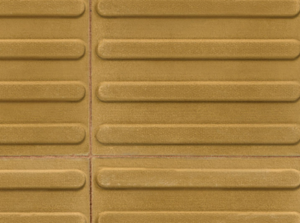
Picture of guidance paving
Cycleway paving
The segregated shared cycle track/footway tactile paving surface profile comprises a series of raised, flat-topped bars.
This is similar to corrugated paving, but the difference is the spacing between the bars (which are wider than guidance paving) and the direction in which the bars are positioned.
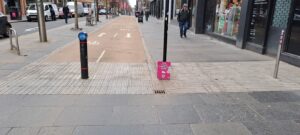
Picture of of cycleway paving used in the direction of the cyclist’s flow.
On the footway side, the surface is laid so that the bars are transversely across the main direction of travel for people walking, and it is called the ‘ladder’ surface in this orientation.
On the cycle trackside, the surface is laid so that the bars align with the main direction of travel for people cycling, which is called the ‘tramline’ surface in this orientation.



 0141 332 4632
0141 332 4632